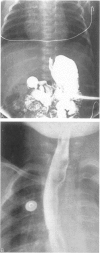Abstract
OBJECTIVE: To determine whether or not a true primary repair, without myotomies and with the gastroesophageal junction below the diaphragm, can be accomplished across the esophageal atresia (EA) spectrum. Our hypothesis is that the esophageal anastomosis can withstand significant tension. The consequences, particularly for those patients with a very long gap atresia, were assessed. SUMMARY OF BACKGROUND DATA: Difficulties arise roughly in proportion to the size of the gap between esophageal segments. Reported surgical complications remain frequent, and particularly at the far end of the EA spectrum, not all children are left with a satisfactorily functioning esophagus or esophageal substitute. METHODS: The outcomes of all infants who had a true primary repair of EA from 1976-1997 were determined. Surgically, the methods used to achieve a reliable true primary repair were expanded to accomplish this, even for a very long gap EA. RESULTS: From 1976-97, 70 infants with or without associated tracheoesophageal fistula (TEF) had primary repairs performed with no surgery-related deaths and 11% later deaths. No interpositions were performed since 1983. There were no discernible anastomotic leaks and one late recurrent TEF related to the early use of balloon dilation. Ten infants had gaps of 5.0-6.8 cm and, among these, four had gaps of 5.5-6.8 cm that could not be pulled together initially. Traction sutures in the esophageal ends, however, produced sufficient lengthening within 6-10 days for a true primary repair. Very long gap repairs produced more reflux (10 of 10 required a fundoplication versus 24 of 70 overall) and more dilations to relieve strictures. Two infants underwent stricture resection with no recurrence. On follow-up, all patients over 2 years of age were eating well or satisfactorily, and none had a gastrostomy tube. CONCLUSIONS: (1) The esophageal anastomosis can withstand considerable tension and allows a reliable true primary repair for the full EA spectrum. (2) Growth is rapid and traction sutures will produce significant esophageal lengthening within days. (3) With increasing tension, gastroesophageal reflux (GER) and strictures are more common; however, both are treatable. Follow-up reveals the benefits of true primary repair over other solutions.
Full text
PDF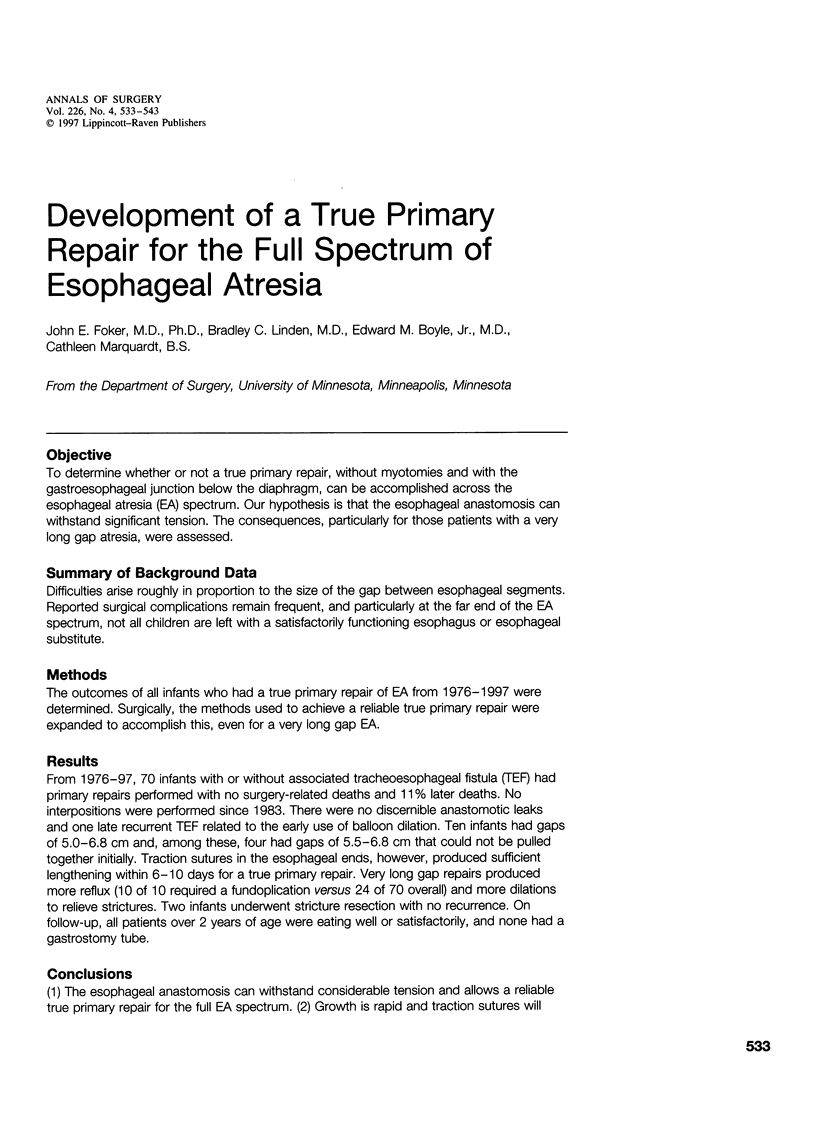
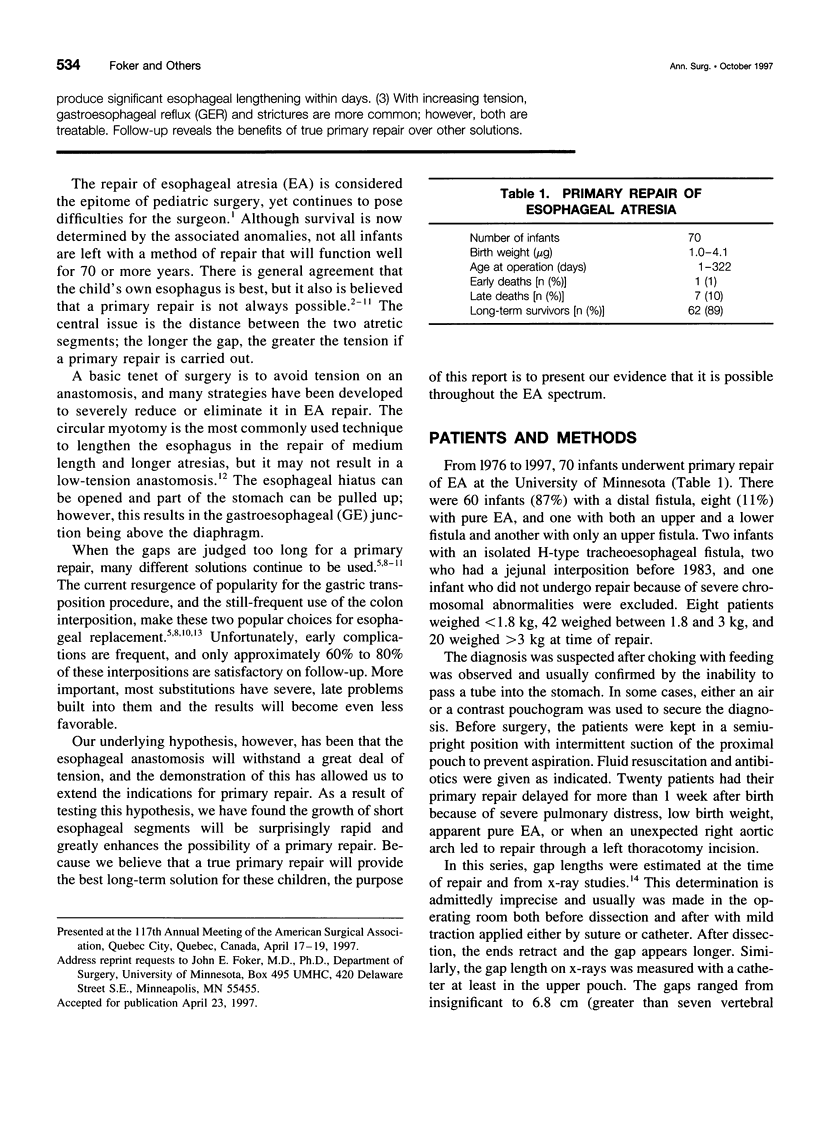
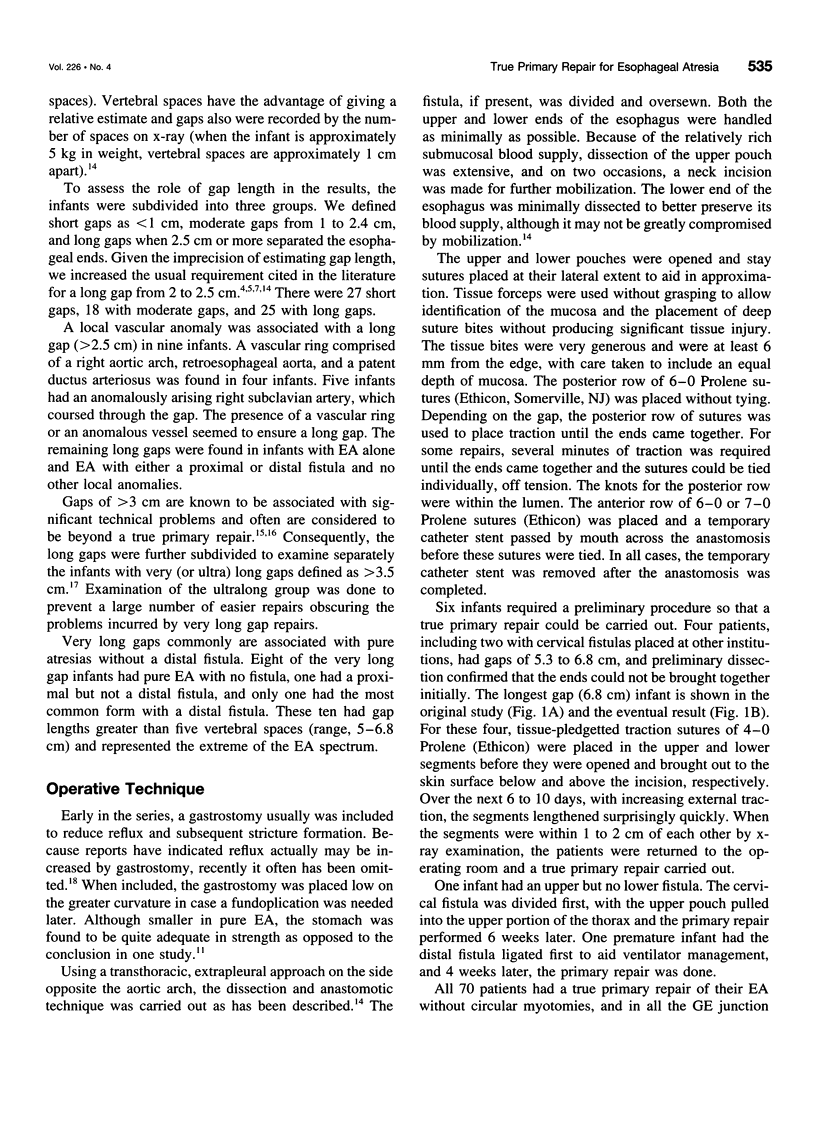

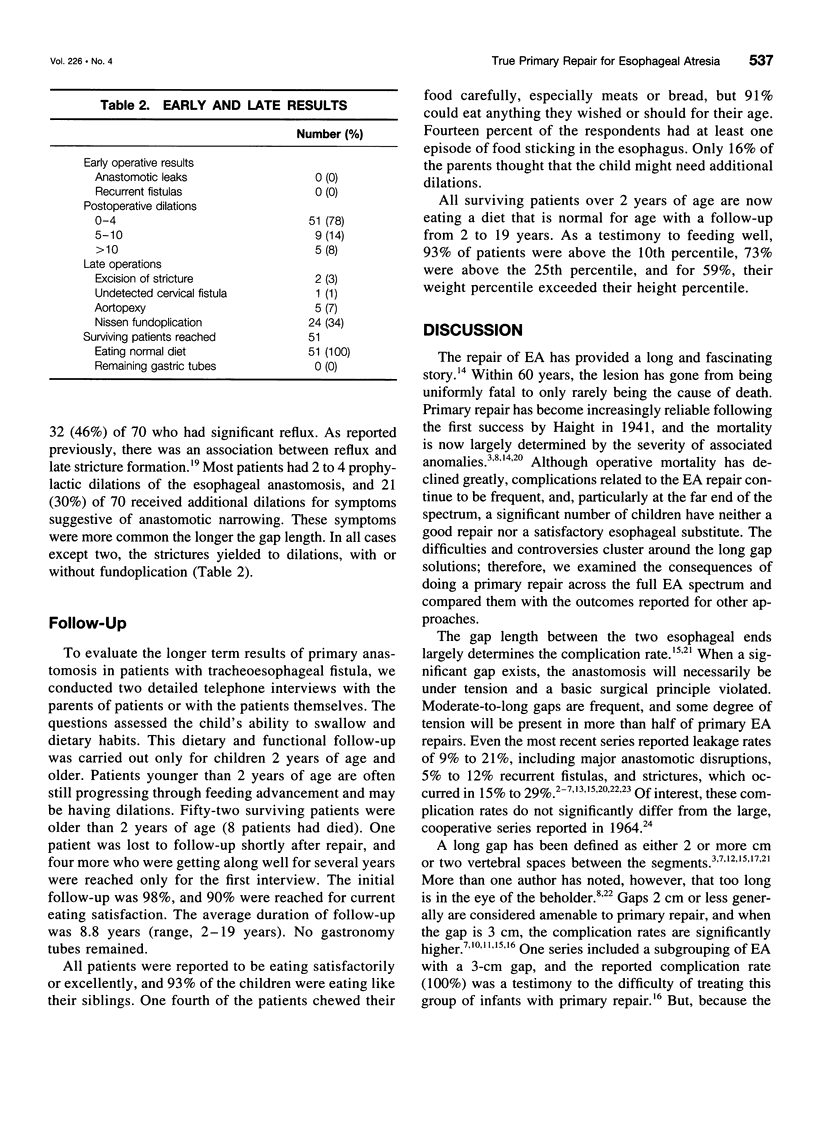
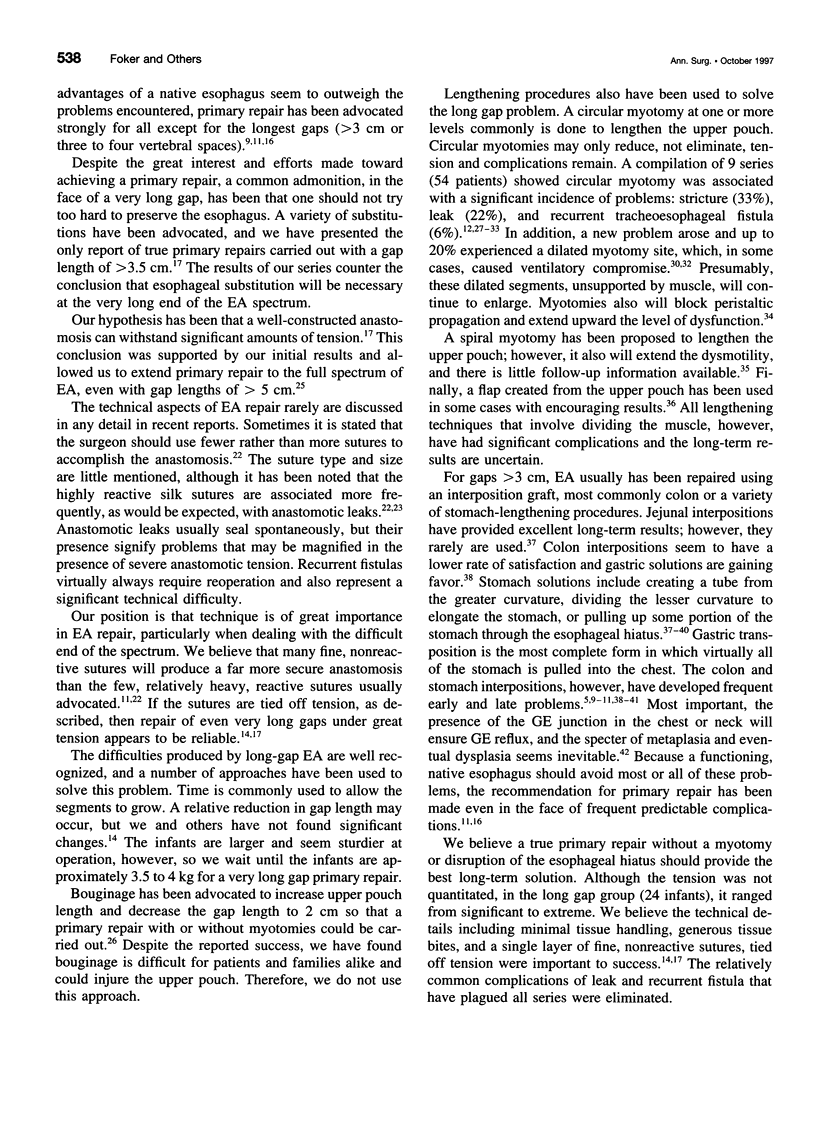
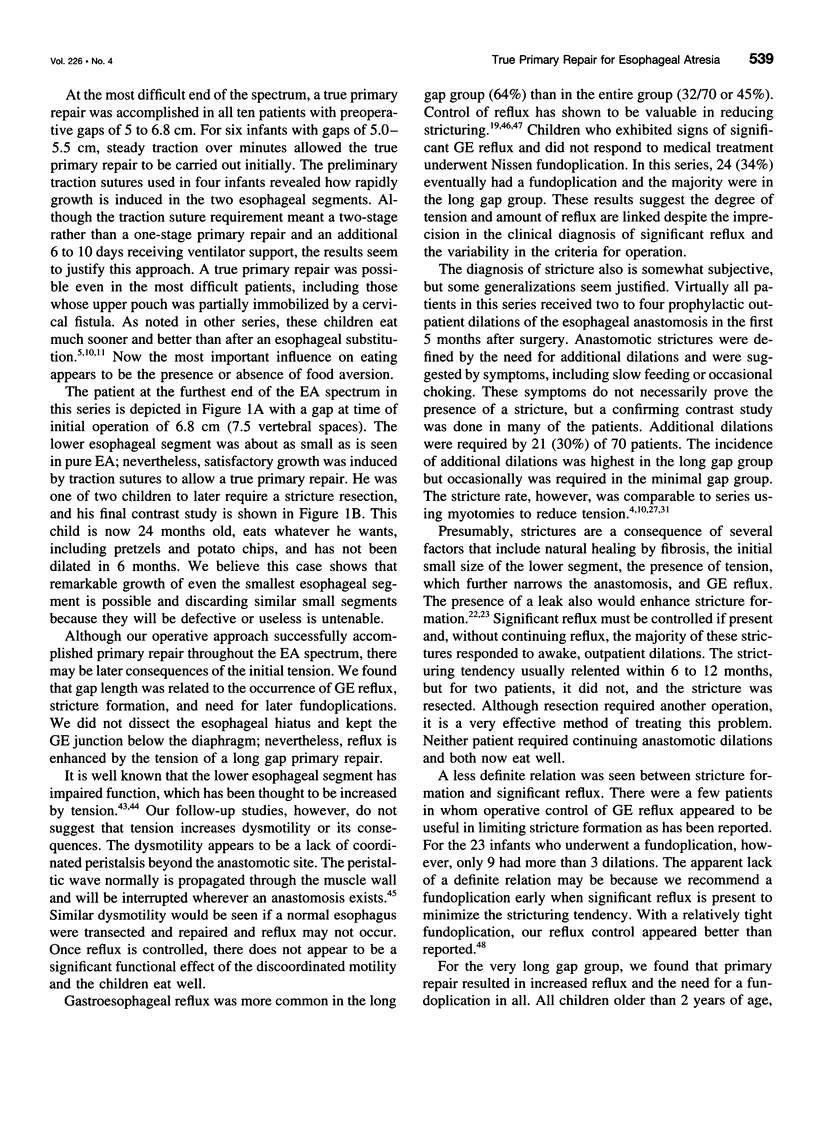
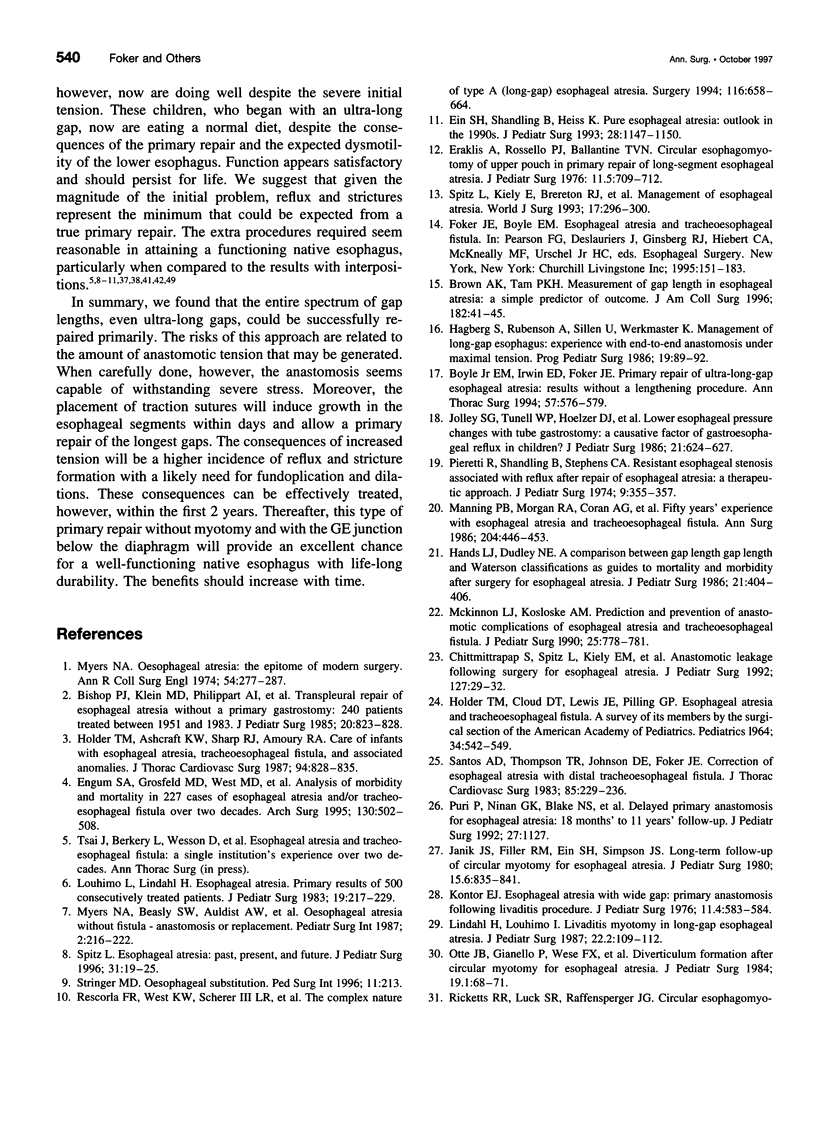
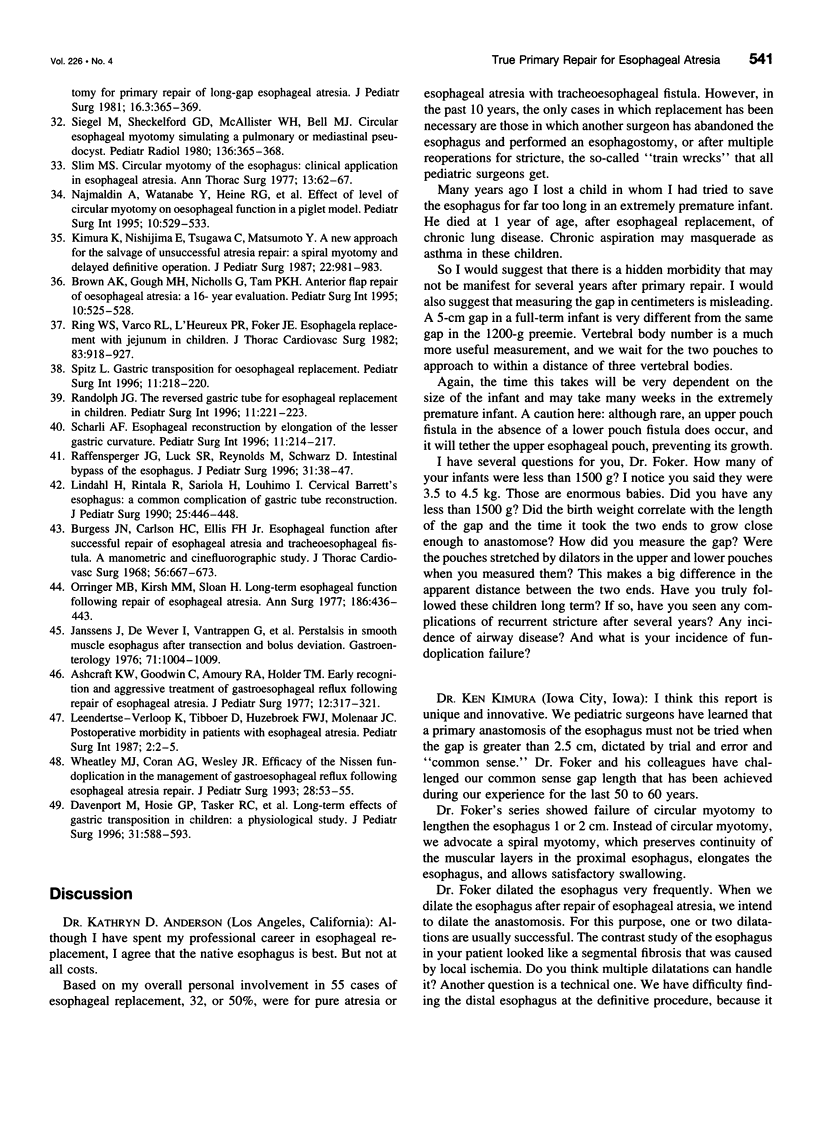
Images in this article
Selected References
These references are in PubMed. This may not be the complete list of references from this article.
- Ashcraft K. W., Goodwin C., Amoury R. A., Holder T. M. Early recognition and aggressive treatment of gastroesophageal reflux following repair of esophageal atresia. J Pediatr Surg. 1977 Jun;12(3):317–321. doi: 10.1016/0022-3468(77)90007-0. [DOI] [PubMed] [Google Scholar]
- Bishop P. J., Klein M. D., Philippart A. I., Hixson D. S., Hertzler J. H. Transpleural repair of esophageal atresia without a primary gastrostomy: 240 patients treated between 1951 and 1983. J Pediatr Surg. 1985 Dec;20(6):823–828. doi: 10.1016/s0022-3468(85)80050-6. [DOI] [PubMed] [Google Scholar]
- Boyle E. M., Jr, Irwin E. D., Foker J. E. Primary repair of ultra-long-gap esophageal atresia: results without a lengthening procedure. Ann Thorac Surg. 1994 Mar;57(3):576–579. doi: 10.1016/0003-4975(94)90548-7. [DOI] [PubMed] [Google Scholar]
- Brown A. K., Tam P. K. Measurement of gap length in esophageal atresia: a simple predictor of outcome. J Am Coll Surg. 1996 Jan;182(1):41–45. [PubMed] [Google Scholar]
- Burgess J. N., Carlson H. C., Ellis F. H., Jr Esophageal function after successful repair of esophageal atresia and tracheoesophageal fistula. A manometric and cinefluorographic study. J Thorac Cardiovasc Surg. 1968 Nov;56(5):667–673. [PubMed] [Google Scholar]
- Chittmittrapap S., Spitz L., Kiely E. M., Brereton R. J. Anastomotic leakage following surgery for esophageal atresia. J Pediatr Surg. 1992 Jan;27(1):29–32. doi: 10.1016/0022-3468(92)90098-r. [DOI] [PubMed] [Google Scholar]
- Davenport M., Hosie G. P., Tasker R. C., Gordon I., Kiely E. M., Spitz L. Long-term effects of gastric transposition in children: a physiological study. J Pediatr Surg. 1996 Apr;31(4):588–593. doi: 10.1016/s0022-3468(96)90503-5. [DOI] [PubMed] [Google Scholar]
- Ein S. H., Shandling B., Heiss K. Pure esophageal atresia: outlook in the 1990s. J Pediatr Surg. 1993 Sep;28(9):1147–1150. doi: 10.1016/0022-3468(93)90151-a. [DOI] [PubMed] [Google Scholar]
- Engum S. A., Grosfeld J. L., West K. W., Rescorla F. J., Scherer L. R., 3rd Analysis of morbidity and mortality in 227 cases of esophageal atresia and/or tracheoesophageal fistula over two decades. Arch Surg. 1995 May;130(5):502–509. doi: 10.1001/archsurg.1995.01430050052008. [DOI] [PubMed] [Google Scholar]
- Eraklis A. J., Rossello P. J., Ballantine T. V. Circular esophagomyotomy of upper pouch in primary repair of long-segment esophageal atresia. J Pediatr Surg. 1976 Oct;11(5):709–712. doi: 10.1016/0022-3468(76)90094-4. [DOI] [PubMed] [Google Scholar]
- HOLDER T. M., CLOUD D. T., LEWIS J. E., Jr, PILLING G. P., 4th ESOPHAGEAL ATRESIA AND TRACHEOESOPHAGEAL FISTULA. A SURVEY OF ITS MEMBERS BY THE SURGICAL SECTION OF THE AMERICAN ACADEMY OF PEDIATRICS. Pediatrics. 1964 Oct;34:542–549. [PubMed] [Google Scholar]
- Hagberg S., Rubenson A., Sillén U., Werkmäster K. Management of long-gap esophagus: experience with end-to-end anastomosis under maximal tension. Prog Pediatr Surg. 1986;19:88–92. doi: 10.1007/978-3-642-70777-3_8. [DOI] [PubMed] [Google Scholar]
- Hands L. J., Dudley N. E. A comparison between gap-length and Waterston classification as guides to mortality and morbidity after surgery for esophageal atresia. J Pediatr Surg. 1986 May;21(5):404–406. doi: 10.1016/s0022-3468(86)80508-5. [DOI] [PubMed] [Google Scholar]
- Holder T. M., Ashcraft K. W., Sharp R. J., Amoury R. A. Care of infants with esophageal atresia, tracheoesophageal fistula, and associated anomalies. J Thorac Cardiovasc Surg. 1987 Dec;94(6):828–835. [PubMed] [Google Scholar]
- Janik J. S., Filler R. M., Ein S. H., Simpson J. S. Long-term follow-up circular myotomy for esophageal atresia. J Pediatr Surg. 1980 Dec;15(6):835–841. doi: 10.1016/s0022-3468(80)80289-2. [DOI] [PubMed] [Google Scholar]
- Janssens J., De Wever I., Vantrappen G., Hellemans J. Peristalsis in smooth muscle esophagus after transection and bolus deviation. Gastroenterology. 1976 Dec;71(6):1004–1009. [PubMed] [Google Scholar]
- Jolley S. G., Tunell W. P., Hoelzer D. J., Thomas S., Smith E. I. Lower esophageal pressure changes with tube gastrostomy: a causative factor of gastroesophageal reflux in children? J Pediatr Surg. 1986 Jul;21(7):624–627. doi: 10.1016/s0022-3468(86)80418-3. [DOI] [PubMed] [Google Scholar]
- Kimura K., Nishijima E., Tsugawa C., Matsumoto Y. A new approach for the salvage of unsuccessful esophageal atresia repair: a spiral myotomy and delayed definitive operation. J Pediatr Surg. 1987 Nov;22(11):981–983. doi: 10.1016/s0022-3468(87)80486-4. [DOI] [PubMed] [Google Scholar]
- Kontor E. J. Esophageal atresia with wide gap: primary anastomosis following Livaditis procedure. J Pediatr Surg. 1976 Aug;11(4):583–584. doi: 10.1016/s0022-3468(76)80019-x. [DOI] [PubMed] [Google Scholar]
- Lindahl H., Louhimo I. Livaditis myotomy in long-gap esophageal atresia. J Pediatr Surg. 1987 Feb;22(2):109–112. doi: 10.1016/s0022-3468(87)80421-9. [DOI] [PubMed] [Google Scholar]
- Lindahl H., Rintala R., Sariola H., Louhimo I. Cervical Barrett's esophagus: a common complication of gastric tube reconstruction. J Pediatr Surg. 1990 Apr;25(4):446–448. doi: 10.1016/0022-3468(90)90391-l. [DOI] [PubMed] [Google Scholar]
- Manning P. B., Morgan R. A., Coran A. G., Wesley J. R., Polley T. Z., Jr, Behrendt D. M., Kirsh M. M., Sloan H. E. Fifty years' experience with esophageal atresia and tracheoesophageal fistula. Beginning with Cameron Haight's first operation in 1935. Ann Surg. 1986 Oct;204(4):446–453. doi: 10.1097/00000658-198610000-00013. [DOI] [PMC free article] [PubMed] [Google Scholar]
- McKinnon L. J., Kosloske A. M. Prediction and prevention of anastomotic complications of esophageal atresia and tracheoesophageal fistula. J Pediatr Surg. 1990 Jul;25(7):778–781. doi: 10.1016/s0022-3468(05)80018-1. [DOI] [PubMed] [Google Scholar]
- Myers N. A. Oesophageal atresia: the epitome of modern surgery. Ann R Coll Surg Engl. 1974 Jun;54(6):277–287. [PMC free article] [PubMed] [Google Scholar]
- Orringer M. B., Kirsh M. M., Sloan H. Long-term esophageal function following repair of esophageal atresia. Ann Surg. 1977 Oct;186(4):436–443. doi: 10.1097/00000658-197710000-00005. [DOI] [PMC free article] [PubMed] [Google Scholar]
- Otte J. B., Gianello P., Wese F. X., Claus D., Verellen G., Moulin D. Diverticulum formation after circular myotomy for esophageal atresia. J Pediatr Surg. 1984 Feb;19(1):68–71. doi: 10.1016/s0022-3468(84)80019-6. [DOI] [PubMed] [Google Scholar]
- Pieretti R., Shandling B., Stephens C. A. Resistant esophageal stenosis associated with reflux after repair of esophageal atresia: a therapeutic approach. J Pediatr Surg. 1974 Jun;9(3):355–357. doi: 10.1016/s0022-3468(74)80292-7. [DOI] [PubMed] [Google Scholar]
- Puri P., Ninan G. K., Blake N. S., Fitzgerald R. J., Guiney E. J., O'Donnell B. Delayed primary anastomosis for esophageal atresia: 18 months' to 11 years' follow-up. J Pediatr Surg. 1992 Aug;27(8):1127–1130. doi: 10.1016/0022-3468(92)90573-p. [DOI] [PubMed] [Google Scholar]
- Raffensperger J. G., Luck S. R., Reynolds M., Schwartz D. Intestinal bypass of the esophagus. J Pediatr Surg. 1996 Jan;31(1):38–47. doi: 10.1016/s0022-3468(96)90316-4. [DOI] [PubMed] [Google Scholar]
- Rescorla F. J., West K. W., Scherer L. R., 3rd, Grosfeld J. L. The complex nature of type A (long-gap) esophageal atresia. Surgery. 1994 Oct;116(4):658–664. [PubMed] [Google Scholar]
- Ring W. S., Varco R. L., L'Heureux P. R., Foker J. E. Esophageal replacement with jejunum in children: an 18 to 33 year follow-up. J Thorac Cardiovasc Surg. 1982 Jun;83(6):918–927. [PubMed] [Google Scholar]
- Santos A. D., Thompson T. R., Johnson D. E., Foker J. E. Correction of esophageal atresia with distal tracheoesophageal fistula. J Thorac Cardiovasc Surg. 1983 Feb;85(2):229–236. [PubMed] [Google Scholar]
- Siegel M. J., Shackelford G. D., McAlister W. H., Bell M. J. Circular esophageal myotomy simulating a pulmonary or mediastinal pseudocyst. Radiology. 1980 Aug;136(2):365–368. doi: 10.1148/radiology.136.2.7403510. [DOI] [PubMed] [Google Scholar]
- Slim M. S. Circular myotomy of the esophagus: clinical application in esophageal atresia. Ann Thorac Surg. 1977 Jan;23:62–66. doi: 10.1016/s0003-4975(10)64071-4. [DOI] [PubMed] [Google Scholar]
- Spitz L. Esophageal atresia: past, present, and future. J Pediatr Surg. 1996 Jan;31(1):19–25. doi: 10.1016/s0022-3468(96)90313-9. [DOI] [PubMed] [Google Scholar]
- Spitz L., Kiely E., Brereton R. J., Drake D. Management of esophageal atresia. World J Surg. 1993 May-Jun;17(3):296–300. doi: 10.1007/BF01658695. [DOI] [PubMed] [Google Scholar]
- Wheatley M. J., Coran A. G., Wesley J. R. Efficacy of the Nissen fundoplication in the management of gastroesophageal reflux following esophageal atresia repair. J Pediatr Surg. 1993 Jan;28(1):53–55. doi: 10.1016/s0022-3468(05)80354-9. [DOI] [PubMed] [Google Scholar]



